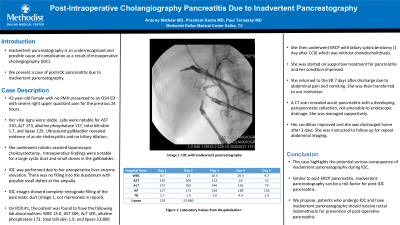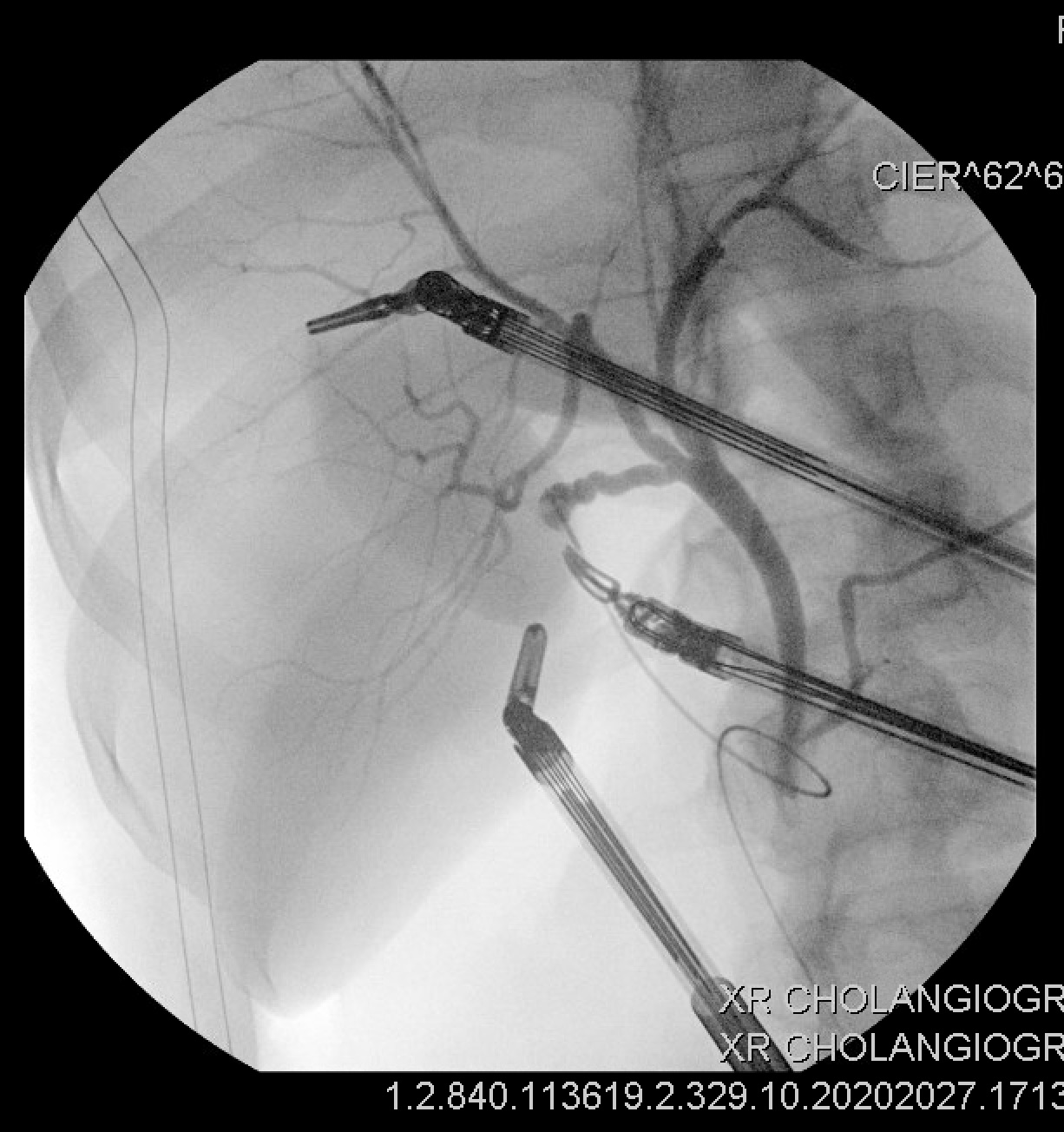Monday Poster Session
Category: Biliary/Pancreas
P1821 - Post-Intraoperative Cholangiography Pancreatitis Due to Inadvertent Pancreatography
Monday, October 28, 2024
10:30 AM - 4:00 PM ET
Location: Exhibit Hall E

Has Audio
- AM
Antony Mathew, MD
Methodist Dallas Medical Center
Dallas, TX
Presenting Author(s)
Antony Mathew, MD, Prashant Kedia, MD, Paul Tarnasky, MD, FACG
Methodist Dallas Medical Center, Dallas, TX
Introduction: Inadvertent pancreatography is an underrecognized and possible cause of complication as a result of intraoperative cholangiography (IOC). Previous studies have revealed conflicting information regarding the clinical significance of reflux of contrast material into the pancreatic duct during IOC. We present a case of post-IOC pancreatitis due to inadvertent pancreatography.
Case Description/Methods: A 42-year-old female with no past medical history presented to an outside hospital with severe right upper quadrant pain for the previous 24 hours. She was hemodynamically stable and afebrile. Labs were notable for AST 310, ALT 173, alkaline phosphatase 117, total bilirubin 1.7, and lipase 129. Ultrasound gallbladder revealed evidence of acute cholecystitis and no biliary dilation. She underwent laparoscopic cholecystectomy (CCX). Intraoperative findings were notable for a large cystic duct and small stones in the gallbladder. Given her preoperative LFT elevations, an IOC was performed. This study reported no filling into the duodenum. On review of images, IOC shows complete retrograde filling of the pancreatic duct (Figure 1). One day after CCX with IOC, the patient is found to have the following lab abnormalities: WBC 15.0, AST 309, ALT 305, alkaline phosphatase 173, total bilirubin 1.9, and lipase 23,880. She then underwent ERCP with biliary sphincterotomy (1 day after CCX) which was grossly normal. She was started on supportive treatment for pancreatitis and her condition improved. She was discharged home but continued to have abdominal pain. She returned to the ER 7 days after discharge and was then transferred to our institution. A CT scan revealed acute pancreatitis with a developing peripancreatic fluid collection. The peripancreatic fluid collection was not amenable to endoscopic drainage. She was managed supportively, her condition improved and she was discharged home.
Discussion: This case highlights the potential serious consequence of inadvertent pancreatography during IOC. We suggest that strategies similar to the prevention of post-ERCP pancreatitis can be drawn upon to prevent the development of post-IOC pancreatitis. We propose, that given the risk benefit tradeoff, patients who undergo IOC and have inadvertent pancreatography should receive rectal indomethacin for prevention of post-IOC pancreatitis. More research is required in regards to the development of this clinical entity and how it can be more appropriately prevented and managed.

Note: The table for this abstract can be viewed in the ePoster Gallery section of the ACG 2024 ePoster Site or in The American Journal of Gastroenterology's abstract supplement issue, both of which will be available starting October 27, 2024.
Disclosures:
Antony Mathew, MD, Prashant Kedia, MD, Paul Tarnasky, MD, FACG. P1821 - Post-Intraoperative Cholangiography Pancreatitis Due to Inadvertent Pancreatography, ACG 2024 Annual Scientific Meeting Abstracts. Philadelphia, PA: American College of Gastroenterology.
Methodist Dallas Medical Center, Dallas, TX
Introduction: Inadvertent pancreatography is an underrecognized and possible cause of complication as a result of intraoperative cholangiography (IOC). Previous studies have revealed conflicting information regarding the clinical significance of reflux of contrast material into the pancreatic duct during IOC. We present a case of post-IOC pancreatitis due to inadvertent pancreatography.
Case Description/Methods: A 42-year-old female with no past medical history presented to an outside hospital with severe right upper quadrant pain for the previous 24 hours. She was hemodynamically stable and afebrile. Labs were notable for AST 310, ALT 173, alkaline phosphatase 117, total bilirubin 1.7, and lipase 129. Ultrasound gallbladder revealed evidence of acute cholecystitis and no biliary dilation. She underwent laparoscopic cholecystectomy (CCX). Intraoperative findings were notable for a large cystic duct and small stones in the gallbladder. Given her preoperative LFT elevations, an IOC was performed. This study reported no filling into the duodenum. On review of images, IOC shows complete retrograde filling of the pancreatic duct (Figure 1). One day after CCX with IOC, the patient is found to have the following lab abnormalities: WBC 15.0, AST 309, ALT 305, alkaline phosphatase 173, total bilirubin 1.9, and lipase 23,880. She then underwent ERCP with biliary sphincterotomy (1 day after CCX) which was grossly normal. She was started on supportive treatment for pancreatitis and her condition improved. She was discharged home but continued to have abdominal pain. She returned to the ER 7 days after discharge and was then transferred to our institution. A CT scan revealed acute pancreatitis with a developing peripancreatic fluid collection. The peripancreatic fluid collection was not amenable to endoscopic drainage. She was managed supportively, her condition improved and she was discharged home.
Discussion: This case highlights the potential serious consequence of inadvertent pancreatography during IOC. We suggest that strategies similar to the prevention of post-ERCP pancreatitis can be drawn upon to prevent the development of post-IOC pancreatitis. We propose, that given the risk benefit tradeoff, patients who undergo IOC and have inadvertent pancreatography should receive rectal indomethacin for prevention of post-IOC pancreatitis. More research is required in regards to the development of this clinical entity and how it can be more appropriately prevented and managed.

Figure: Figure 1: IOC with inadvertent pancreatography
Note: The table for this abstract can be viewed in the ePoster Gallery section of the ACG 2024 ePoster Site or in The American Journal of Gastroenterology's abstract supplement issue, both of which will be available starting October 27, 2024.
Disclosures:
Antony Mathew indicated no relevant financial relationships.
Prashant Kedia indicated no relevant financial relationships.
Paul Tarnasky indicated no relevant financial relationships.
Antony Mathew, MD, Prashant Kedia, MD, Paul Tarnasky, MD, FACG. P1821 - Post-Intraoperative Cholangiography Pancreatitis Due to Inadvertent Pancreatography, ACG 2024 Annual Scientific Meeting Abstracts. Philadelphia, PA: American College of Gastroenterology.
